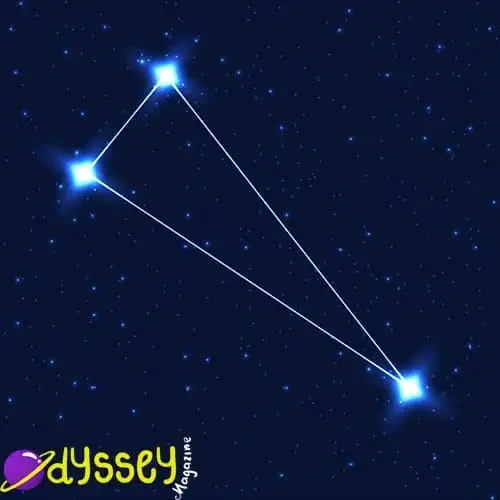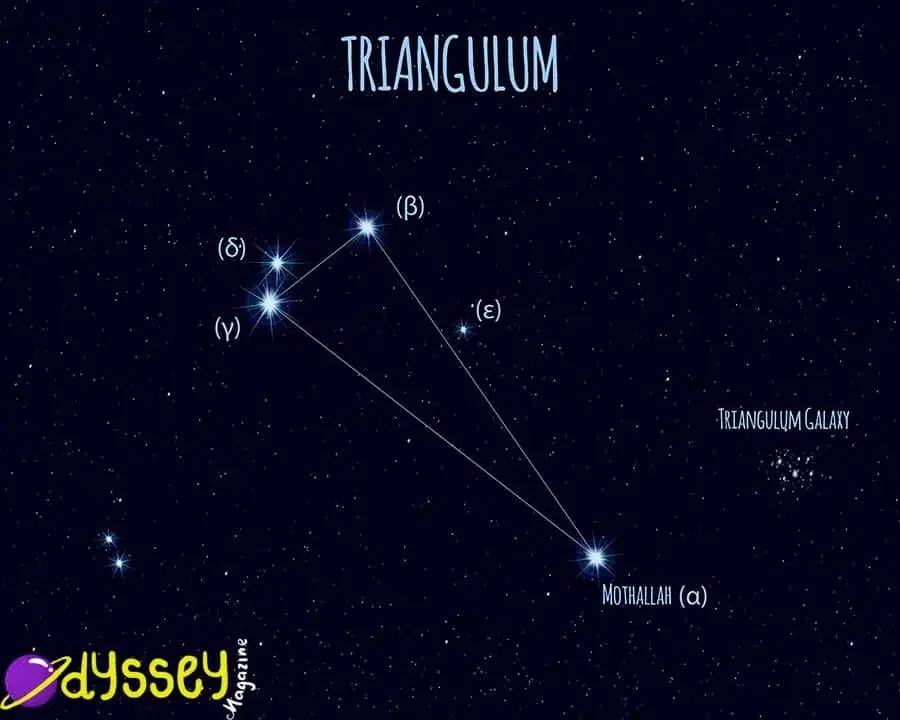Triangulum Constellation | The Triangle
Triangulum, as you’d probably expect, takes it’s name from the Latin for Triangle. It contains several galaxies, with the brightest being the Triangulum galaxy. Although we don’t have any writings of Triangulum until Ptolemy in the 2nd Century, it was likely that it was noticed far further back than this, and Ptolemy’s writings indicated that the Babylonian’s also identified Triangulum. Lets look at some facts about this constellation.

- Bordered By; Andromeda, Pisces, Aries, Perseus.
- Named after; The Triangle
- Declination; +25°-37°
- Brightest Star; Beta Trianguli
- Best seen; September
- Size rank; 78th
- Constellation family; Perseus
- Pronunciation; TRY-ANG-GUE-LUM
Triangulum, as you’ve probably guessed, is just taken from the Latin word for triangle. It actually originated with the Babylonian’s, who combined the stars of Triangulum with the third brightest star of Andromeda, Gamma Andromedae, to create a constellation known as The Plough.
As with many of our constellations, the first writings we have about it are actually in taken from Ptolemy’s Algamest, which is one of the most well known and respected scientific texts throughout time. Ptolemy took a lot of his observations from the Babylonians. Triangulum was likely referred to as Deltoton amongst the Greek’s, as it looked like the Greek letter delta (Δ).
Triangulum is bordered by Aries, Pisces, Perseus and Andromeda. It is probably easiest to find by trying to find Andromeda, which has a similar declination making it viewable much of the year by those in the Northern Hemisphere.
Triangulum is made up of five main stars, which you can link together to form a triangle. As well as this, you can also see the Triangulum galaxy in this constellation too. You can match up the stars with the image below.

- Beta Trianguli (β) – Beta Trianguli is the brightest star in the constellation, and makes up one of the points of the triangle. It is comprised of a binary star, the stronger of which is a subgiant star. It is estimated to be more than 127 light years away from us.
- Alpha Trianguli (α) – The second brightest star in this constellation is Alpha Trianguli, sometimes referred to as Mothallah. It is another spectroscopic binary star; this means that it is actually two stars, but we cannot see them clearly to know they both exist, so we only know this through the stars reflection. This star is estimated to be more than 1.6 billion years old.
- Gamma Trianguli (γ) – The final point of the triangle is made up by Gamma Trianguli. This star is 112 light years away from us, has 33x the luminosity of the Sun, and is approximately 300 million years old.
- Delta Trianguli (δ) – Delta Trianguli is made up of two stars in a binary system, a yellow star matched by an orange dwarf star.
- Epsilon Trianguli (ε) – The Epsilon Trianguli actually has a lot in common with the stars of the Big Dipper, as they are all part of the Ursa Major Moving Group, which was made for stars that have similar velocities and spaces in time. It’s a binary star system, with an approximate 3x radius of the Sun.
Also located in the Triangulum constellation is the Triangulum galaxy, also referred to as Messier 33. It is a large galaxy, only succeeded by the Milky Way and the Andromeda Galaxy. It’s possible to see the Triangulum galaxy with the naked eye with clear skies, and it has a diameter of approximately 60,000 light years.
To sum it up, Triangulum isn’t one of the bigger constellations, but it is typically quite easy to find in the Northern Hemisphere, as it is positioned next to the Andromeda constellation and Aries. It also included the impressive Triangulum galaxy, too.